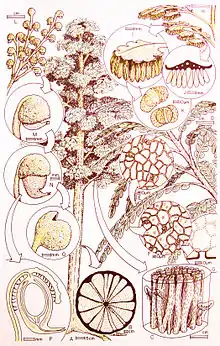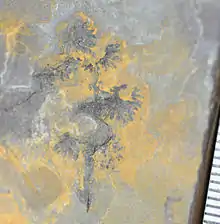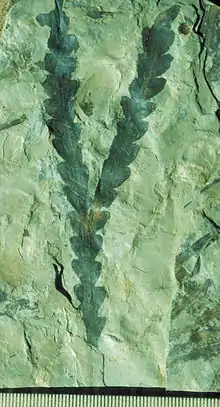Corystospermaceae
Corystosperms are a group of extinct seed plants (often referred to as "seed ferns") belonging to the family Corystospermaceae (also called Umkomasiaceae) assigned to the order Corystospermales[2] or Umkomasiales.[3] They were first described based on fossils collected by Hamshaw Thomas from the Burnera Waterfall locality near the Umkomaas River of South Africa.[4] Corystosperms are typified by a group of plants that bore forked Dicroidium leaves, Umkomasia cupulate ovulate structures and Pteruchus pollen organs, which grew as trees that were widespread over Gondwana during the Middle and Late Triassic. Other fossil Mesozoic seed plants with similar leaf and/or reproductive structures have also sometimes been included within the "corystosperm" concept sensu lato, such as the "doyleoids" from the Early Cretaceous of North America and Asia.[3] A potential corystosperm sensu lato, the leaf genus Komlopteris, is known from the Eocene of Tasmania, around 53-50 million years old, over 10 million years after the Cretaceous–Paleogene extinction event.[5]

| Corystospermaceae Temporal range: | |
|---|---|
 | |
| Umkomasia macleanii reconstructed plant, Late Triassic, Molteno Formation, Umkomaas, South Africa. Including Dicroidium leaves (D), Umkomasia ovulate organ (L-P), and Pteruchus pollen organ (H-K)[1] | |
| Scientific classification | |
| Kingdom: | Plantae |
| Order: | †Corystospermales |
| Family: | †Corystospermaceae Thomas 1933 |
| Genera | |
| |
| Synonyms | |
| |
Description
Classic Umkomasiaceae have helmet-like cupules around ovules born in complex large branching structures (Umkomasia). The pollen organ (Pteruchus) has numerous cigar-shaped pollen sacs hanging from epaulette-like blades, again in complex branching structures.
The architecture and size of Dicroidium leaves is highly variable, going from simple to tripinnate, to needle-like to lobed or dissected leaflets, however, all leaves are united by being bifurcated at the base.[6]
Evolutionary history
The oldest fossils of corystosperms, belonging to Dicroidium, Pteruchus and Umkomasia date to the Late Permian in the low-latitudes of eastern Gondwana, including the Umm Irna Formation of Jordan, as well as the Indian subcontinent,[7][8][9] though possible pollen belonging to the group is also known from the Late Permian of South Africa.[10] During the Middle-Late Triassic, Dicroidium bearing corystosperms were widespread and dominant trees over temperate areas of southern Gondwana (including the Indian subcontinent, South America, Southern Africa, Antarctica, Australia and New Zealand) including wetland and forest environments, where they formed part of the canopy vegetation.[6][11] Dicroidium-bearing corystosperm ecosystems collapsed as a result of the end-Triassic extinction event. Late surviving Dicroidium-bearing corystosperms are known from the Early Jurassic (Sinemurian) of East Antarctica.[6] During the Jurassic, the possible corystosperms Pachypteris and Komlopteris were widespread over both hemispheres,[12] with Komlopteris surviving in the Southern Hemisphere through the Cretaceous and into the early Eocene in Tasmania, making it the last surviving "seed fern" in the fossil record.[5][12] A group of plants with corystosperm-like reproductive structures, either considered corystosperms or as belonging to the separate order Doyleales, were present in North America and Asia during the Early Cretaceous,[3] with records of the group possibly extending back as far as the Early Jurassic.[13]
Relationships to other seed plants
The relationships of corystosperms to other seed plants are contentious.[14] It has been suggested that some "peltasperms" may be closely related to corystosperms.[15] A 2016 paper suggested that they may be closely related to Ginkgoales,[16] while a 2021 study suggested that based on the structure of their ovulate organs, corystosperms might form part of the "Anthophyte" clade more closely related to flowering plants than to living gymnosperms, alongside the Petriellales, Caytoniales, and glossopterids.[17]


See also
References
- Retallack, G.J.; Dilcher, D.L. (1988). "Reconstructions of selected seed ferns". Missouri Botanical Garden Annals. 75 (3): 1010–1057. doi:10.2307/2399379. JSTOR 2399379.
- Abu Hamad, A.; Blomenkemper, P.; Kerp, H.; Bomfleur, B. (December 2017). "Dicroidium bandelii sp. nov. (corystospermalean foliage) from the Permian of Jordan". PalZ. 91 (4): 641–648. doi:10.1007/s12542-017-0384-2. ISSN 0031-0220.
- Shi, Gongle; Herrera, Fabiany; Herendeen, Patrick S.; Clark, Elizabeth G.; Crane, Peter R. (2022-12-31). "Silicified cupulate seed-bearing structures from the Early Cretaceous of eastern Inner Mongolia, China: rethinking the corystosperm concept". Journal of Systematic Palaeontology. 20 (1): 1–33. doi:10.1080/14772019.2022.2133644. ISSN 1477-2019. S2CID 253562726.
- Thomas, H.H. (1933). "On some pteridospermous plants from the Mesozoic rocks of South Africa". Philosophical Transactions of the Royal Society B. 222 (483–493): 193–265. doi:10.1098/rstb.1932.0016.
- McLoughlin, Stephen; Carpenter, Raymond J.; Jordan, Gregory J.; Hill, Robert S. (2008). "Seed ferns survived the end-Cretaceous mass extinction in Tasmania". American Journal of Botany. 95 (4): 465–471. doi:10.3732/ajb.95.4.465. ISSN 1537-2197. PMID 21632371.
- Bomfleur, Benjamin; Blomenkemper, Patrick; Kerp, Hans; McLoughlin, Stephen (2018), "Polar Regions of the Mesozoic–Paleogene Greenhouse World as Refugia for Relict Plant Groups", Transformative Paleobotany, Elsevier, pp. 593–611, doi:10.1016/b978-0-12-813012-4.00024-3, ISBN 978-0-12-813012-4, retrieved 2020-11-12
- Blomenkemper, Patrick; Kerp, Hans; Abu Hamad, Abdalla; Bomfleur, Benjamin (July 2020). "Contributions towards whole-plant reconstructions of Dicroidium plants (Umkomasiaceae) from the Permian of Jordan". Review of Palaeobotany and Palynology. 278: 104210. doi:10.1016/j.revpalbo.2020.104210.
- Patrick Blomenkemper; Hans Kerp; Abdalla Abu Hamad; William A. DiMichele; Benjamin Bomfleur (2018). "A hidden cradle of plant evolution in Permian tropical lowlands". Science. 362 (6421): 1414–1416. Bibcode:2018Sci...362.1414B. doi:10.1126/science.aau4061. PMID 30573628.
- Schneebeli-Hermann, Elke; Kürschner, Wolfram M.; Kerp, Hans; Bomfleur, Benjamin; Hochuli, Peter A.; Bucher, Hugo; Ware, David; Roohi, Ghazala (April 2015). "Vegetation history across the Permian–Triassic boundary in Pakistan (Amb section, Salt Range)". Gondwana Research. 27 (3): 911–924. Bibcode:2015GondR..27..911S. doi:10.1016/j.gr.2013.11.007.
- Gastaldo, Robert A.; Bamford, Marion K. (August 2023). "The influence of taphonomy and time on the paleobotanical record of the Permian–Triassic transition of the Karoo basin (and elsewhere)". Journal of African Earth Sciences. 204: 104960. doi:10.1016/j.jafrearsci.2023.104960.
- Blomenkemper, Patrick; Kerp, Hans; Abu Hamad, Abdalla; Bomfleur, Benjamin (July 2020). "Contributions towards whole-plant reconstructions of Dicroidium plants (Umkomasiaceae) from the Permian of Jordan". Review of Palaeobotany and Palynology. 278: 104210. doi:10.1016/j.revpalbo.2020.104210.
- Slodownik, Miriam; Hill, Robert S.; McLoughlin, Stephen (October 2023). "Komlopteris: A persistent lineage of post-Triassic corystosperms in Gondwana". Review of Palaeobotany and Palynology. 317: 104950. doi:10.1016/j.revpalbo.2023.104950.
- Elgorriaga, Andres; Atkinson, Brian A. (July 2023). "Zirabia cylindrica comb. nov. provides evidence of Doyleales in the Jurassic". American Journal of Botany. 110 (7). doi:10.1002/ajb2.16182. ISSN 0002-9122.
- Taylor, Edith L.; Taylor, Thomas N. (January 2009). "Seed ferns from the late Paleozoic and Mesozoic: Any angiosperm ancestors lurking there?". American Journal of Botany. 96 (1): 237–251. doi:10.3732/ajb.0800202. ISSN 0002-9122.
- Elgorriaga, Andrés; Escapa, Ignacio H.; Cúneo, N. Rubén (July 2019). "Relictual Lepidopteris (Peltaspermales) from the Early Jurassic Cañadón Asfalto Formation, Patagonia, Argentina". International Journal of Plant Sciences. 180 (6): 578–596. doi:10.1086/703461. ISSN 1058-5893.
- Shi, Gongle; Leslie, Andrew B.; Herendeen, Patrick S.; Herrera, Fabiany; Ichinnorov, Niiden; Takahashi, Masamichi; Knopf, Patrick; Crane, Peter R. (June 2016). "Early Cretaceous Umkomasia from Mongolia: implications for homology of corystosperm cupules". New Phytologist. 210 (4): 1418–1429. doi:10.1111/nph.13871. ISSN 0028-646X.
- Shi, Gongle; Herrera, Fabiany; Herendeen, Patrick S.; Clark, Elizabeth G.; Crane, Peter R. (2021-06-10). "Mesozoic cupules and the origin of the angiosperm second integument". Nature. 594 (7862): 223–226. doi:10.1038/s41586-021-03598-w. ISSN 0028-0836.
External links
- "Fossilworks: Lepidopteris". paleodb.org. Retrieved 2016-03-18.